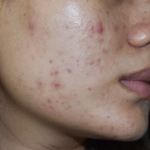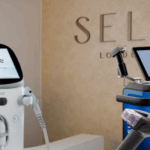
Perimenopause, Skin, and Structure: A Deep Dive into Biological Change and Evidence-Based Care
Perimenopause is a profound biological transition that impacts not only menstrual cycles and hormone levels but also the fundamental physiology of the skin and the body’s structural framework. This period, which can extend over a decade leading up to menopause, is characterised by fluctuating and ultimately declining levels of oestrogen and progesterone, hormones that play critical roles far beyond reproduction. The systemic effects of these hormonal shifts become increasingly evident in the skin’s architecture, hydration levels, resilience, and the integrity of muscle and connective tissue that maintain posture and facial contours.
A comprehensive understanding of the precise mechanisms underlying these changes during perimenopause is essential to develop informed and effective care strategies. This article explores the complex biology behind the visible and invisible changes that occur, examines evidence-based interventions capable of supporting skin and structure during this time, and highlights the indispensable role of clinical expertise in safely and effectively delivering these treatments.
The Biological Basis of Perimenopausal Skin Ageing
The dermis, the layer of skin located beneath the epidermis or barrier, owes much of its tensile strength and elasticity to collagen types I and III, which are produced primarily by fibroblasts. Oestrogen is a key modulator of fibroblast activity, not only stimulating collagen synthesis but also inhibiting the enzymes responsible for collagen degradation, such as collagenases. During perimenopause, the decline in circulating oestrogen leads to several critical changes at the cellular level. Fibroblast proliferation and synthetic capacity diminish, while there is an upregulation of matrix metalloproteinases (MMPs), particularly MMP-1 and MMP-3, which accelerate collagen breakdown. Simultaneously, transforming growth factor-beta (TGF-β) signalling pathways, which normally maintain and repair the extracellular matrix, become impaired. Together, these alterations culminate in a net loss of collagen within the dermis, with studies documenting a reduction of up to 30% in dermal collagen content within five years after menopause. Clinically, this manifests as thinning skin, a loss of firmness, and the deepening of wrinkles, particularly in regions where the skin is naturally thinner, such as the neck and lower face.
Hyaluronic acid (HA), a glycosaminoglycan highly abundant in the dermis, plays a pivotal role in retaining water and maintaining skin turgor. Its synthesis is regulated in part by oestrogen through the activity of hyaluronan synthase enzymes within fibroblasts. Perimenopause is accompanied by a significant decline in dermal HA levels, which leads to increased transepidermal water loss and diminished hydration of the skin. This physiological deficit contributes to the characteristic dryness and crepiness commonly reported by women during this stage of life. Importantly, the loss of HA occurs deep within the dermal layers and cannot be fully compensated for by topical moisturisers, whose molecular size prevents penetration into these deeper tissues.
The sebaceous glands, responsible for producing sebum which forms a vital component of the skin’s lipid barrier, are also influenced by fluctuating sex hormones including oestrogen and androgens. As hormone levels change, sebaceous gland activity typically declines, resulting in a weaker lipid barrier that increases skin susceptibility to dryness, sensitivity, and irritation. This compromised barrier not only exacerbates dryness but also impairs the skin’s ability to repair itself, promoting a cycle of inflammation and accelerated ageing.
Perimenopause also increases the skin’s vulnerability to oxidative damage due to heightened production of reactive oxygen species (ROS) and a decline in the skin’s antioxidant defences. ROS inflict damage by causing DNA strand breaks, lipid peroxidation, and protein cross-linking within skin cells, all of which undermine cellular function and viability. Concurrently, advanced glycation end products (AGEs), formed by the non-enzymatic binding of sugars to collagen and elastin fibres, accumulate more rapidly with advancing age and metabolic dysfunction. AGEs contribute to skin ageing by stiffening collagen fibres, reducing elasticity, and inducing inflammatory signalling through receptor-mediated pathways. These biochemical insults collectively erode the structural integrity of the skin.
Mitochondria, the cell’s powerhouses responsible for ATP production, exhibit reduced function with age, leading to diminished energy supply and increased ROS generation. In dermal fibroblasts, mitochondrial decline reduces their capacity to synthesise collagen and hyaluronic acid, while also impairing repair mechanisms. The accumulation of mitochondrial dysfunction and other damage leads to cellular senescence, a state in which fibroblasts and keratinocytes enter a dysfunctional phase characterised by the secretion of pro-inflammatory factors. This senescence-associated secretory phenotype promotes degradation of the extracellular matrix and propagates skin ageing.
Muscle loss, known as sarcopenia, accelerates during perimenopause as a consequence of hormonal decline and reduced anabolic signalling. It is estimated that muscle mass declines by approximately three to eight percent per decade after the age of thirty, with a marked acceleration after fifty. Beyond its mechanical role, skeletal muscle functions as an endocrine organ, secreting myokines such as irisin and interleukin-6 (IL-6) that modulate systemic inflammation, glucose metabolism, and adipose tissue function. The loss of muscle mass therefore contributes to systemic insulin resistance, chronic low-grade inflammation, and reduced metabolic flexibility, all of which have adverse downstream effects on skin health. Structurally, muscle provides essential support to the skin and the underlying skeletal framework; the reduction of muscle tone leads to changes in facial contours, postural alterations, and diminished mechanical support for the skin, thereby exacerbating skin laxity and the visual signs of ageing.
Lifestyle and Nutritional Considerations
While clinical interventions play a key role in managing perimenopausal changes, nutrition and lifestyle factors significantly modulate skin and structural health during this period. Adequate protein intake is crucial for preserving muscle mass, and micronutrients such as vitamin C, zinc, and copper serve as essential cofactors in collagen synthesis and skin repair. Polyphenols and antioxidants sourced from a balanced diet support mitochondrial function and help reduce oxidative stress. Additionally, sufficient hydration, restorative sleep, and effective stress management influence systemic inflammation levels and enhance skin regenerative processes.
Evidence-Based Interventions: Mechanisms and Rationale
Among the most effective treatments for perimenopausal skin changes are light-based therapies, including BroadBand Light (BBL) and fractional resurfacing with the HALO laser. BBL utilises a spectrum of light wavelengths to target specific chromophores in the skin, such as melanin and haemoglobin. Through selective photothermolysis, BBL reduces pigmentation irregularities and vascular redness. Furthermore, the treatment induces a controlled thermal effect within the dermis, stimulating fibroblast activity and encouraging the synthesis of new collagen, which in turn improves skin tone and texture.
The HALO laser combines ablative and non-ablative fractional wavelengths to create microscopic zones of controlled thermal injury within the skin. This precise injury triggers a complex wound-healing cascade, activating fibroblasts to produce new collagen and elastin. By improving skin texture, reducing fine lines, and promoting cellular turnover, HALO addresses many of the ageing-related changes characteristic of perimenopausal skin. Its fractional delivery method spares surrounding tissue, allowing for more rapid recovery compared to full ablative resurfacing, making it suitable for skin with diminished regenerative capacity.
Sofwave ultrasound treatment delivers focused thermal energy to the mid-dermis, specifically targeting a depth of approximately 1.5 millimeters where collagen production is most active. This focused energy creates a controlled thermal coagulation effect that recruits heat shock proteins and stimulates fibroblast activation. The result is thickening and realignment of collagen fibres, restoring firmness and providing a lifting effect that is particularly valuable in areas prone to laxity, such as the jawline and neck, lower face and brows. Sofwave’s gentle but effective mechanism, combined with minimal downtime, renders it appropriate for perimenopausal skin often characterised by barrier impairment.
Profhilo is an injectable stabilised hyaluronic acid preparation with a low degree of cross-linking, allowing it to diffuse through superficial subcutaneous tissues and deeply hydrate the dermis. Beyond hydration, Profhilo stimulates resident fibroblasts and keratinocytes to produce collagen and elastin by activating biochemical signalling pathways. The enhancement of skin viscoelasticity and suppleness achieved through Profhilo improves skin quality without volumising, making it an ideal intervention for the hydration deficits typical of perimenopausal skin. Clinical studies demonstrate notable improvements in skin elasticity, hydration, and overall texture following Profhilo treatment.
Muscle preservation is a vital component of maintaining skin support and systemic health during perimenopause. Pure Impact employs high-intensity focused electromagnetic technology to elicit supramaximal muscle contractions that activate deep and fast-twitch muscle fibres prone to sarcopenic decline. These contractions surpass what can be achieved voluntarily, stimulating muscle hypertrophy and strength gains. The associated release of myokines during treatment exerts systemic anti-inflammatory effects and enhances insulin sensitivity, thereby mitigating metabolic declines often associated with perimenopause. Maintaining muscle tone through Pure Impact contributes to better posture and sustains the mechanical scaffold necessary for youthful skin appearance.
EmFemme addresses the pelvic floor, an often overlooked but vital structure impacted by oestrogen decline during perimenopause. The resultant decrease in collagen synthesis within pelvic floor connective tissues leads to diminished muscle tone and function, contributing to core instability and associated discomfort. EmFemme utilises targeted radiofrequency energy to stimulate collagen remodelling and induce neuromuscular contractions within the pelvic floor muscles. This enhances muscle strength, endurance, and coordination, thereby supporting core stability and improving overall postural balance. By reinforcing the pelvic floor, EmFemme complements facial and body rejuvenation efforts, contributing to a holistic approach to wellbeing during perimenopause.
Expertise Matters More Than Technology
Despite the considerable potential of these advanced technologies, their success is inextricably linked to clinical expertise. Effective treatment requires thorough patient assessment, including hormonal status and detailed skin physiology evaluation. Treatment planning must be individualised, considering each patient’s unique biology and goals. The precision of treatment delivery, involving careful adjustment of parameters to balance safety and efficacy, alongside the strategic sequencing and combination of interventions, maximises synergistic outcomes. Ongoing monitoring and adaptation of protocols based on patient progress ensure the highest standards of care.
At Self London, every intervention is delivered within a medically led framework, where clinical judgement governs the use of technology. This approach minimises risk, enhances therapeutic outcomes, and supports long-term patient wellbeing. Patients are advised to remain cautious of practices that offer initial consultations only to delegate treatments to less experienced providers or promote discounted device access without clinical oversight. It is the expertise, not mere device ownership, that determines natural and lasting results.
Navigating Perimenopause with Informed Agency
Perimenopause represents a critical phase with systemic impacts extending beyond superficial skin changes. A clear understanding of its biological underpinnings empowers women to make informed choices aligned with their personal health needs and values. Evidence-based interventions that respect physiological realities offer pathways to support skin integrity, preserve structural function, and maintain confidence without unrealistic promises. These decisions remain deeply personal and are best undertaken in partnership with trusted clinical experts prioritising safety, health, and sustained outcomes.





